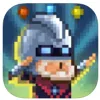Take a look inside 5 images
The Sandbox
Pros: Hundreds of elements and features give kids creative control as they build original worlds.
Cons: Pixelated design takes some adjusting to, as does learning to use allotted resources without spending currency too quickly.
Bottom Line: Encourages creativity and critical thinking as kids create their own universes, but requires a lot of paid extensions to advance.
Most teachers will find that The Sandbox works best as a tool to use with early finishers or as part of enrichment time. However, teachers who have the opportunity to incorporate game-based learning in the classroom may find themselves making time for the game on a regular basis, helping students build crucial problem-solving and critical-thinking skills. This works particularly well in STEAM-based classrooms and may prove ideal for a technology-based class or an art class, where teachers have a little more creative freedom when it comes to their curriculum.
The Sandbox introduces kids to the process of creating a universe. To begin, they can create their own universe in free-play mode without any guidelines, or they can opt to participate in a campaign. In campaign mode, kids work side-by-side with a creator as they learn about the different elements and how to combine those elements. With the creator's guidance, they also begin to build their own worlds. When they first start playing, kids have a set amount of currency, called mana, to spend within the game -- and they'll find they spend it fairly quickly. They can earn new mana by connecting through Facebook or by watching a video; they also have the option of purchasing more mana as well as special extension packs. Although kids can enjoy the basics of the game without purchasing additional mana or extension packs, their experience will be limited.
Some updated features are provided in the Amplify tablet version of The Sandbox. For example, in free play, kids can undo their last action, and they can use a pause-and-play feature. Fewer levels are available in the tablet version than in the standard version, but between the free-play and challenge mode, kids still have plenty of opportunities to create and learn.
On Day 1 of campaign mode, kids learn how combining water and soil makes mud, and how letting water erode stone helps create sand. It's in these small tasks that learning takes place. The game presents these bits of information as essential to the game, so kids indirectly learn bits of information related to science and math. As they continue to play, they'll learn a little about geometry, engineering, physics, geology, biology, and other areas of math and science. However, a lack of explicit lessons means parents and teachers may want to help kids make a connection between what's going on in the game and the academic content they're learning.












